Investigation of Capacitor Charging and Discharging in DC Circuits
VerifiedAdded on 2022/08/21
|14
|2120
|14
Practical Assignment
AI Summary
This assignment investigates the charging and discharging behavior of a capacitor in a DC circuit. The student conducted an experiment, collecting data on voltage changes over time during both charging and discharging phases. The assignment includes calculations of the time constant (RC) and compares recorded voltage values with calculated values using the formula Vc= V0(1-e-t/RC) for charging and an equivalent formula for discharging. The student analyzes the impact of the resistor and capacitor values on the charging and discharging times, providing graphs to illustrate the voltage changes. The document covers the theoretical concepts of capacitance, time constants, and the process of energy storage in a capacitor's electric field, and concludes with a comparison of recorded and calculated values, and a discussion of the charging and discharging characteristics of capacitors.
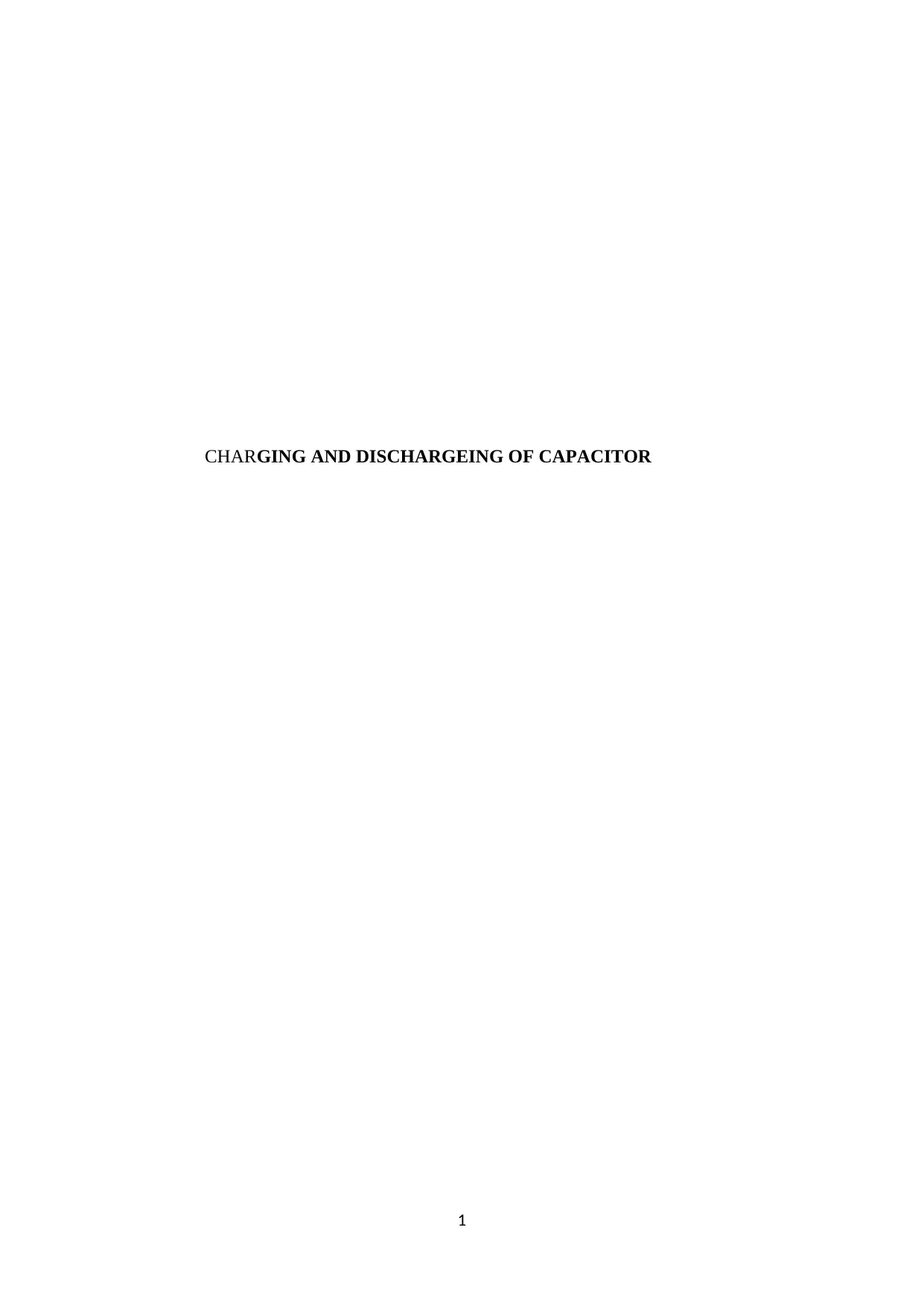
CHARGING AND DISCHARGEING OF CAPACITOR
1
1
Paraphrase This Document
Need a fresh take? Get an instant paraphrase of this document with our AI Paraphraser
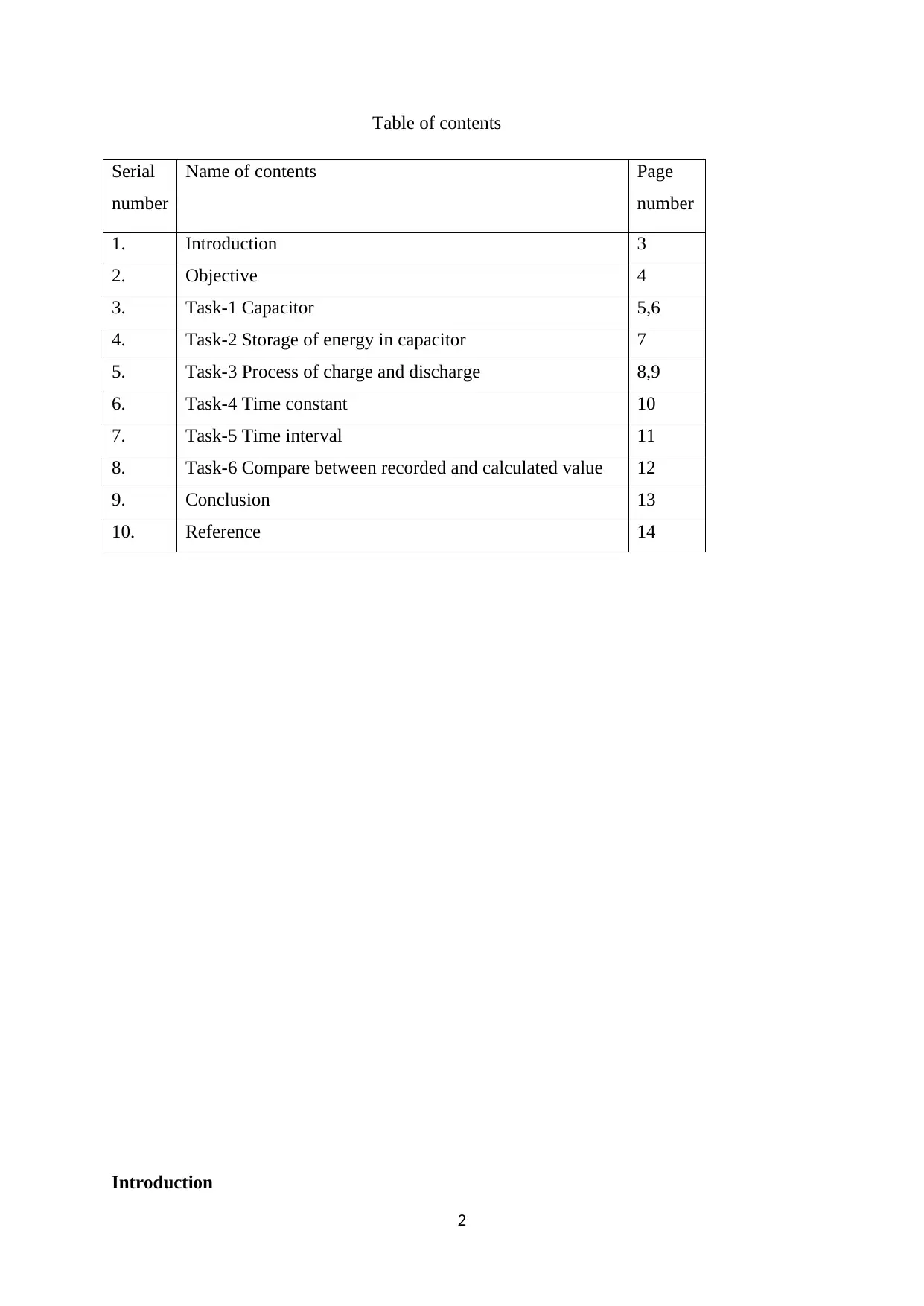
Table of contents
Serial
number
Name of contents Page
number
1. Introduction 3
2. Objective 4
3. Task-1 Capacitor 5,6
4. Task-2 Storage of energy in capacitor 7
5. Task-3 Process of charge and discharge 8,9
6. Task-4 Time constant 10
7. Task-5 Time interval 11
8. Task-6 Compare between recorded and calculated value 12
9. Conclusion 13
10. Reference 14
Introduction
2
Serial
number
Name of contents Page
number
1. Introduction 3
2. Objective 4
3. Task-1 Capacitor 5,6
4. Task-2 Storage of energy in capacitor 7
5. Task-3 Process of charge and discharge 8,9
6. Task-4 Time constant 10
7. Task-5 Time interval 11
8. Task-6 Compare between recorded and calculated value 12
9. Conclusion 13
10. Reference 14
Introduction
2
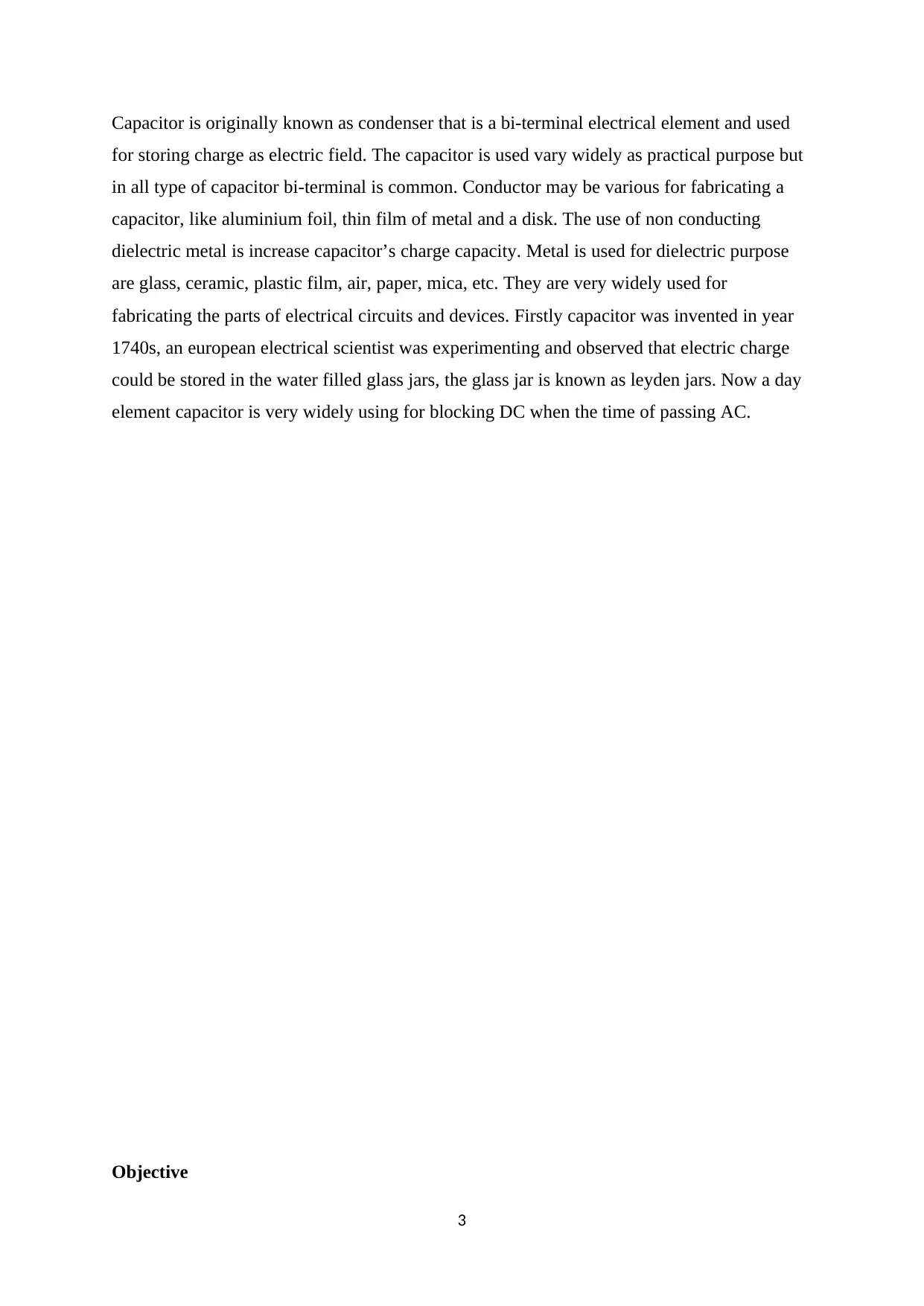
Capacitor is originally known as condenser that is a bi-terminal electrical element and used
for storing charge as electric field. The capacitor is used vary widely as practical purpose but
in all type of capacitor bi-terminal is common. Conductor may be various for fabricating a
capacitor, like aluminium foil, thin film of metal and a disk. The use of non conducting
dielectric metal is increase capacitor’s charge capacity. Metal is used for dielectric purpose
are glass, ceramic, plastic film, air, paper, mica, etc. They are very widely used for
fabricating the parts of electrical circuits and devices. Firstly capacitor was invented in year
1740s, an european electrical scientist was experimenting and observed that electric charge
could be stored in the water filled glass jars, the glass jar is known as leyden jars. Now a day
element capacitor is very widely using for blocking DC when the time of passing AC.
Objective
3
for storing charge as electric field. The capacitor is used vary widely as practical purpose but
in all type of capacitor bi-terminal is common. Conductor may be various for fabricating a
capacitor, like aluminium foil, thin film of metal and a disk. The use of non conducting
dielectric metal is increase capacitor’s charge capacity. Metal is used for dielectric purpose
are glass, ceramic, plastic film, air, paper, mica, etc. They are very widely used for
fabricating the parts of electrical circuits and devices. Firstly capacitor was invented in year
1740s, an european electrical scientist was experimenting and observed that electric charge
could be stored in the water filled glass jars, the glass jar is known as leyden jars. Now a day
element capacitor is very widely using for blocking DC when the time of passing AC.
Objective
3
⊘ This is a preview!⊘
Do you want full access?
Subscribe today to unlock all pages.

Trusted by 1+ million students worldwide
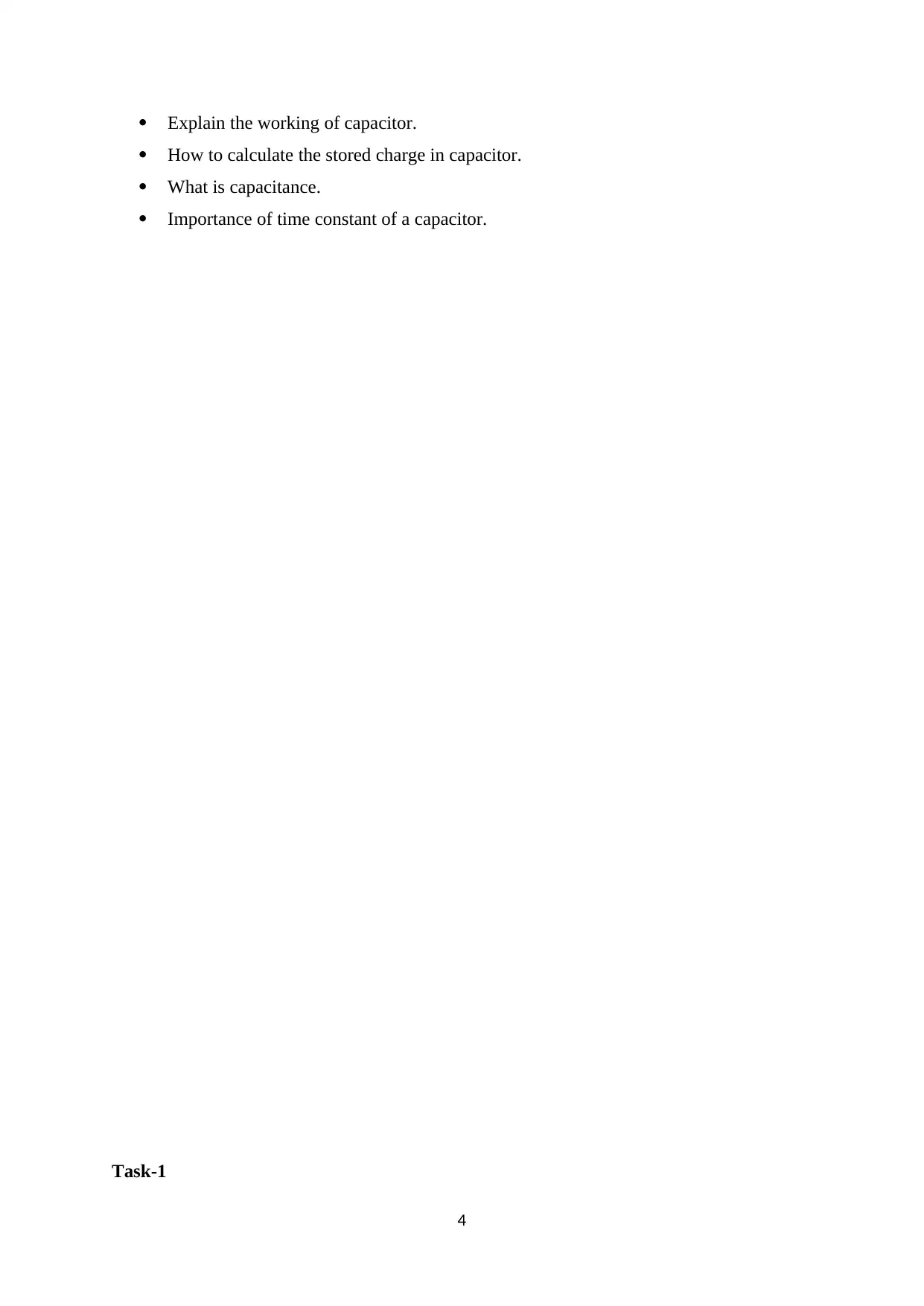
Explain the working of capacitor.
How to calculate the stored charge in capacitor.
What is capacitance.
Importance of time constant of a capacitor.
Task-1
4
How to calculate the stored charge in capacitor.
What is capacitance.
Importance of time constant of a capacitor.
Task-1
4
Paraphrase This Document
Need a fresh take? Get an instant paraphrase of this document with our AI Paraphraser
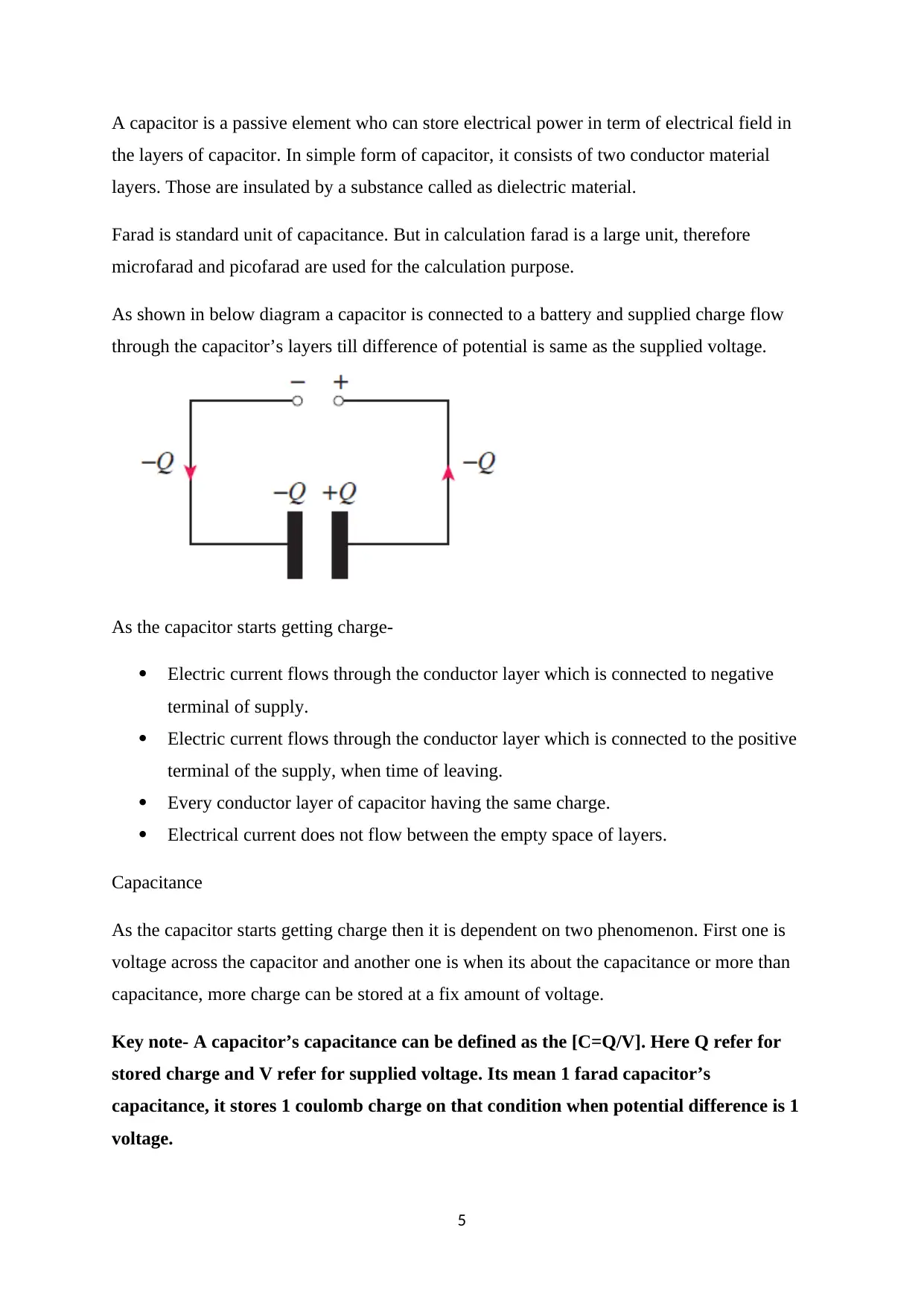
A capacitor is a passive element who can store electrical power in term of electrical field in
the layers of capacitor. In simple form of capacitor, it consists of two conductor material
layers. Those are insulated by a substance called as dielectric material.
Farad is standard unit of capacitance. But in calculation farad is a large unit, therefore
microfarad and picofarad are used for the calculation purpose.
As shown in below diagram a capacitor is connected to a battery and supplied charge flow
through the capacitor’s layers till difference of potential is same as the supplied voltage.
As the capacitor starts getting charge-
Electric current flows through the conductor layer which is connected to negative
terminal of supply.
Electric current flows through the conductor layer which is connected to the positive
terminal of the supply, when time of leaving.
Every conductor layer of capacitor having the same charge.
Electrical current does not flow between the empty space of layers.
Capacitance
As the capacitor starts getting charge then it is dependent on two phenomenon. First one is
voltage across the capacitor and another one is when its about the capacitance or more than
capacitance, more charge can be stored at a fix amount of voltage.
Key note- A capacitor’s capacitance can be defined as the [C=Q/V]. Here Q refer for
stored charge and V refer for supplied voltage. Its mean 1 farad capacitor’s
capacitance, it stores 1 coulomb charge on that condition when potential difference is 1
voltage.
5
the layers of capacitor. In simple form of capacitor, it consists of two conductor material
layers. Those are insulated by a substance called as dielectric material.
Farad is standard unit of capacitance. But in calculation farad is a large unit, therefore
microfarad and picofarad are used for the calculation purpose.
As shown in below diagram a capacitor is connected to a battery and supplied charge flow
through the capacitor’s layers till difference of potential is same as the supplied voltage.
As the capacitor starts getting charge-
Electric current flows through the conductor layer which is connected to negative
terminal of supply.
Electric current flows through the conductor layer which is connected to the positive
terminal of the supply, when time of leaving.
Every conductor layer of capacitor having the same charge.
Electrical current does not flow between the empty space of layers.
Capacitance
As the capacitor starts getting charge then it is dependent on two phenomenon. First one is
voltage across the capacitor and another one is when its about the capacitance or more than
capacitance, more charge can be stored at a fix amount of voltage.
Key note- A capacitor’s capacitance can be defined as the [C=Q/V]. Here Q refer for
stored charge and V refer for supplied voltage. Its mean 1 farad capacitor’s
capacitance, it stores 1 coulomb charge on that condition when potential difference is 1
voltage.
5
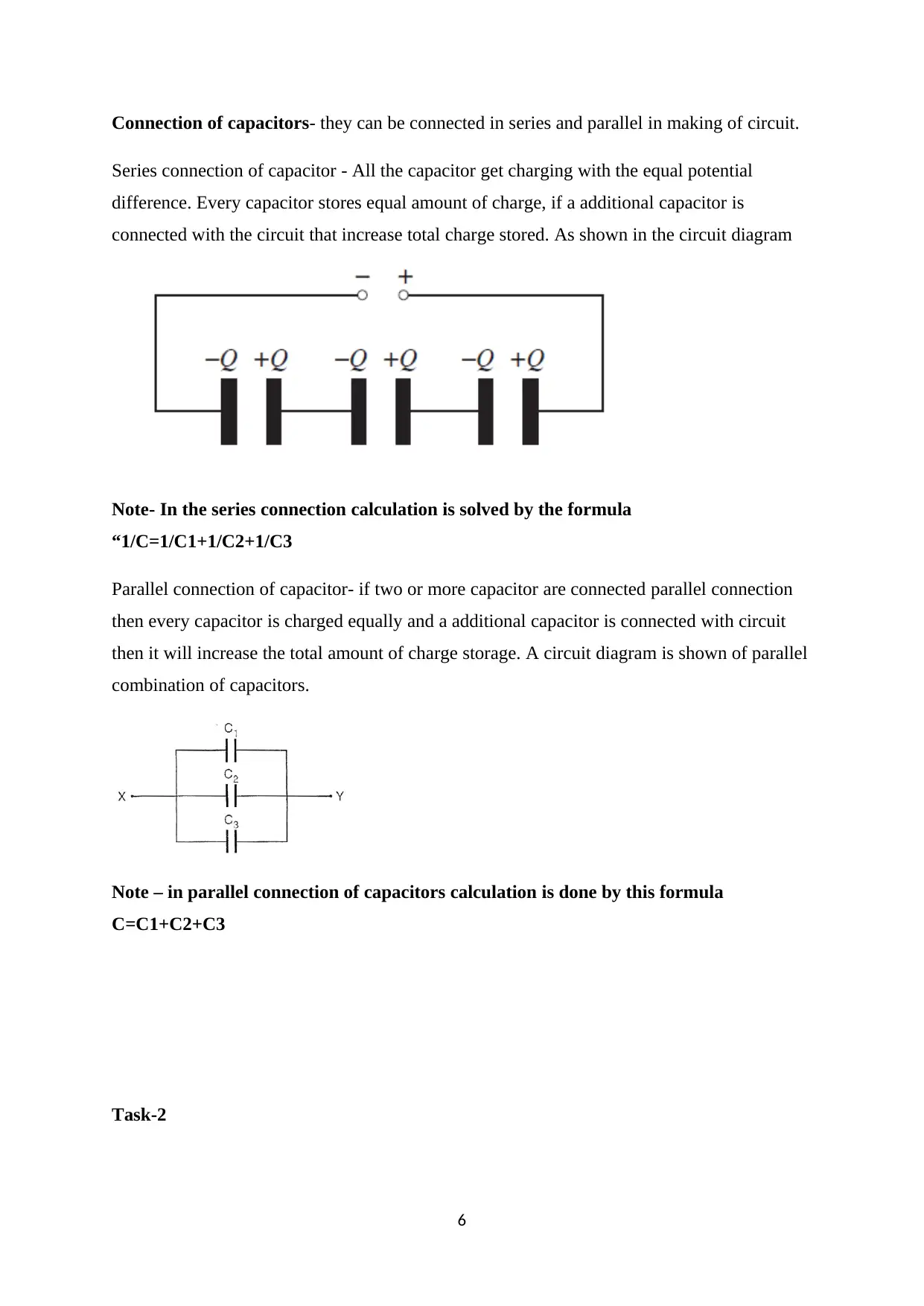
Connection of capacitors- they can be connected in series and parallel in making of circuit.
Series connection of capacitor - All the capacitor get charging with the equal potential
difference. Every capacitor stores equal amount of charge, if a additional capacitor is
connected with the circuit that increase total charge stored. As shown in the circuit diagram
Note- In the series connection calculation is solved by the formula
“1/C=1/C1+1/C2+1/C3
Parallel connection of capacitor- if two or more capacitor are connected parallel connection
then every capacitor is charged equally and a additional capacitor is connected with circuit
then it will increase the total amount of charge storage. A circuit diagram is shown of parallel
combination of capacitors.
Note – in parallel connection of capacitors calculation is done by this formula
C=C1+C2+C3
Task-2
6
Series connection of capacitor - All the capacitor get charging with the equal potential
difference. Every capacitor stores equal amount of charge, if a additional capacitor is
connected with the circuit that increase total charge stored. As shown in the circuit diagram
Note- In the series connection calculation is solved by the formula
“1/C=1/C1+1/C2+1/C3
Parallel connection of capacitor- if two or more capacitor are connected parallel connection
then every capacitor is charged equally and a additional capacitor is connected with circuit
then it will increase the total amount of charge storage. A circuit diagram is shown of parallel
combination of capacitors.
Note – in parallel connection of capacitors calculation is done by this formula
C=C1+C2+C3
Task-2
6
⊘ This is a preview!⊘
Do you want full access?
Subscribe today to unlock all pages.

Trusted by 1+ million students worldwide
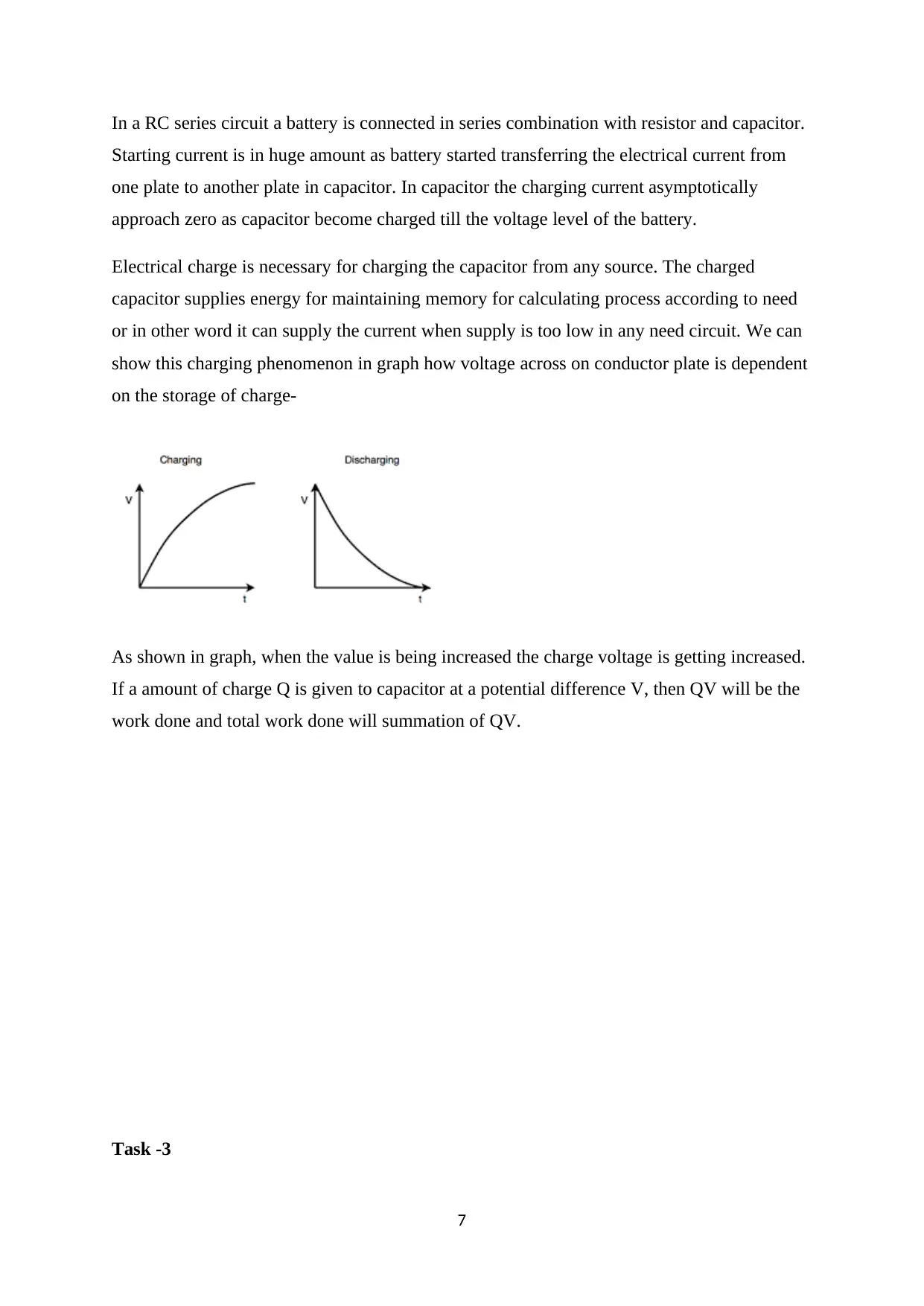
In a RC series circuit a battery is connected in series combination with resistor and capacitor.
Starting current is in huge amount as battery started transferring the electrical current from
one plate to another plate in capacitor. In capacitor the charging current asymptotically
approach zero as capacitor become charged till the voltage level of the battery.
Electrical charge is necessary for charging the capacitor from any source. The charged
capacitor supplies energy for maintaining memory for calculating process according to need
or in other word it can supply the current when supply is too low in any need circuit. We can
show this charging phenomenon in graph how voltage across on conductor plate is dependent
on the storage of charge-
As shown in graph, when the value is being increased the charge voltage is getting increased.
If a amount of charge Q is given to capacitor at a potential difference V, then QV will be the
work done and total work done will summation of QV.
Task -3
7
Starting current is in huge amount as battery started transferring the electrical current from
one plate to another plate in capacitor. In capacitor the charging current asymptotically
approach zero as capacitor become charged till the voltage level of the battery.
Electrical charge is necessary for charging the capacitor from any source. The charged
capacitor supplies energy for maintaining memory for calculating process according to need
or in other word it can supply the current when supply is too low in any need circuit. We can
show this charging phenomenon in graph how voltage across on conductor plate is dependent
on the storage of charge-
As shown in graph, when the value is being increased the charge voltage is getting increased.
If a amount of charge Q is given to capacitor at a potential difference V, then QV will be the
work done and total work done will summation of QV.
Task -3
7
Paraphrase This Document
Need a fresh take? Get an instant paraphrase of this document with our AI Paraphraser
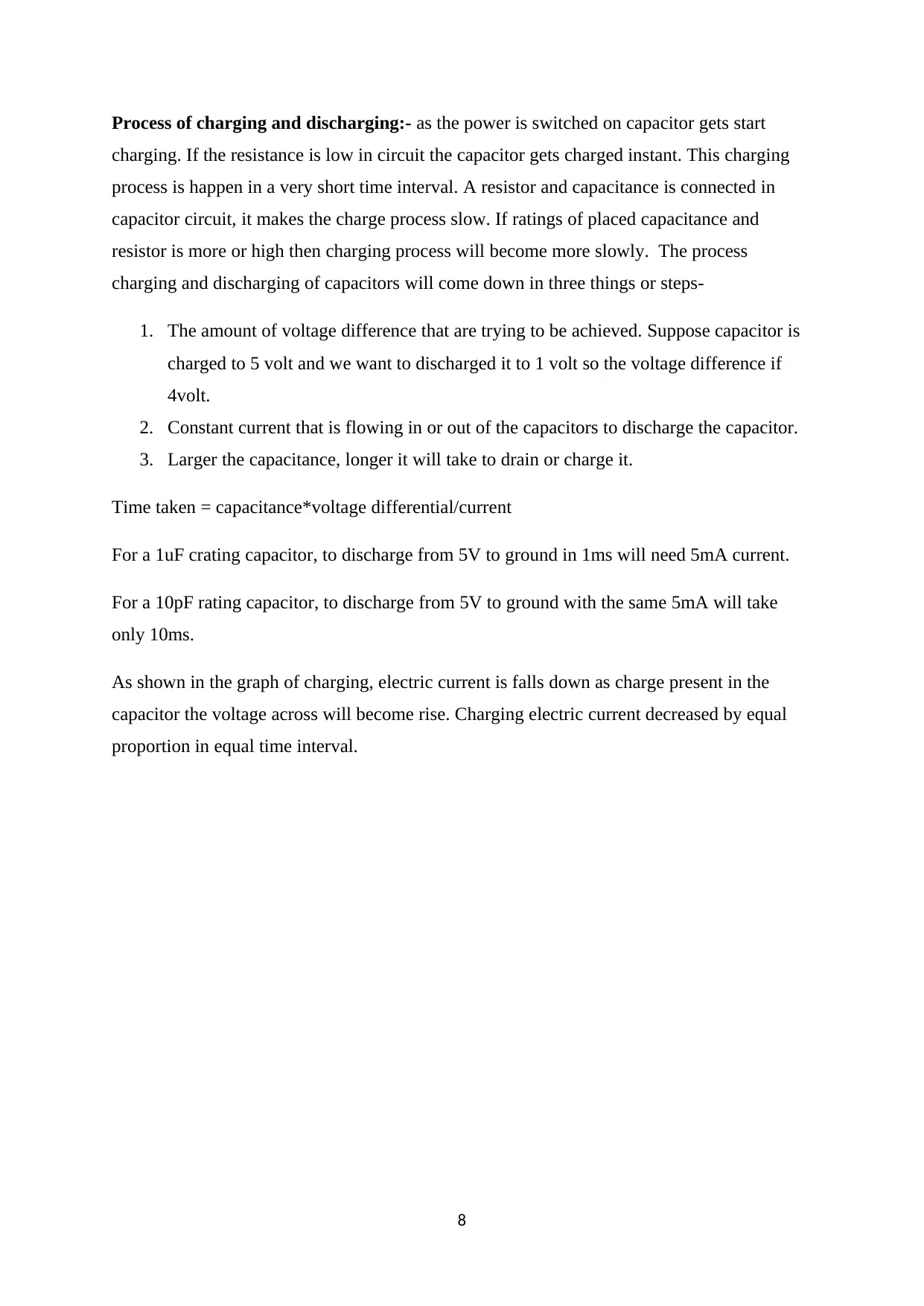
Process of charging and discharging:- as the power is switched on capacitor gets start
charging. If the resistance is low in circuit the capacitor gets charged instant. This charging
process is happen in a very short time interval. A resistor and capacitance is connected in
capacitor circuit, it makes the charge process slow. If ratings of placed capacitance and
resistor is more or high then charging process will become more slowly. The process
charging and discharging of capacitors will come down in three things or steps-
1. The amount of voltage difference that are trying to be achieved. Suppose capacitor is
charged to 5 volt and we want to discharged it to 1 volt so the voltage difference if
4volt.
2. Constant current that is flowing in or out of the capacitors to discharge the capacitor.
3. Larger the capacitance, longer it will take to drain or charge it.
Time taken = capacitance*voltage differential/current
For a 1uF crating capacitor, to discharge from 5V to ground in 1ms will need 5mA current.
For a 10pF rating capacitor, to discharge from 5V to ground with the same 5mA will take
only 10ms.
As shown in the graph of charging, electric current is falls down as charge present in the
capacitor the voltage across will become rise. Charging electric current decreased by equal
proportion in equal time interval.
8
charging. If the resistance is low in circuit the capacitor gets charged instant. This charging
process is happen in a very short time interval. A resistor and capacitance is connected in
capacitor circuit, it makes the charge process slow. If ratings of placed capacitance and
resistor is more or high then charging process will become more slowly. The process
charging and discharging of capacitors will come down in three things or steps-
1. The amount of voltage difference that are trying to be achieved. Suppose capacitor is
charged to 5 volt and we want to discharged it to 1 volt so the voltage difference if
4volt.
2. Constant current that is flowing in or out of the capacitors to discharge the capacitor.
3. Larger the capacitance, longer it will take to drain or charge it.
Time taken = capacitance*voltage differential/current
For a 1uF crating capacitor, to discharge from 5V to ground in 1ms will need 5mA current.
For a 10pF rating capacitor, to discharge from 5V to ground with the same 5mA will take
only 10ms.
As shown in the graph of charging, electric current is falls down as charge present in the
capacitor the voltage across will become rise. Charging electric current decreased by equal
proportion in equal time interval.
8
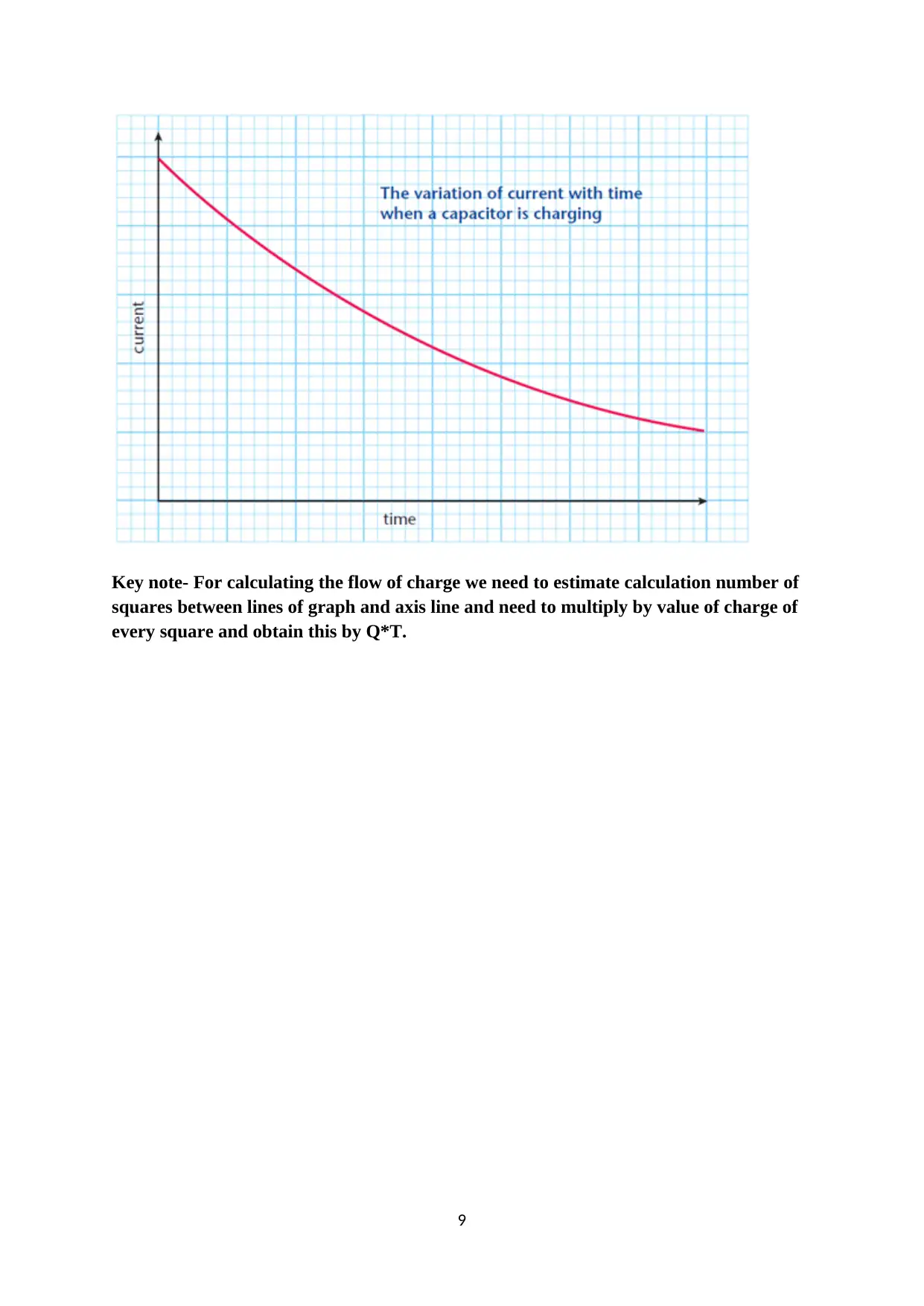
Key note- For calculating the flow of charge we need to estimate calculation number of
squares between lines of graph and axis line and need to multiply by value of charge of
every square and obtain this by Q*T.
9
squares between lines of graph and axis line and need to multiply by value of charge of
every square and obtain this by Q*T.
9
⊘ This is a preview!⊘
Do you want full access?
Subscribe today to unlock all pages.

Trusted by 1+ million students worldwide
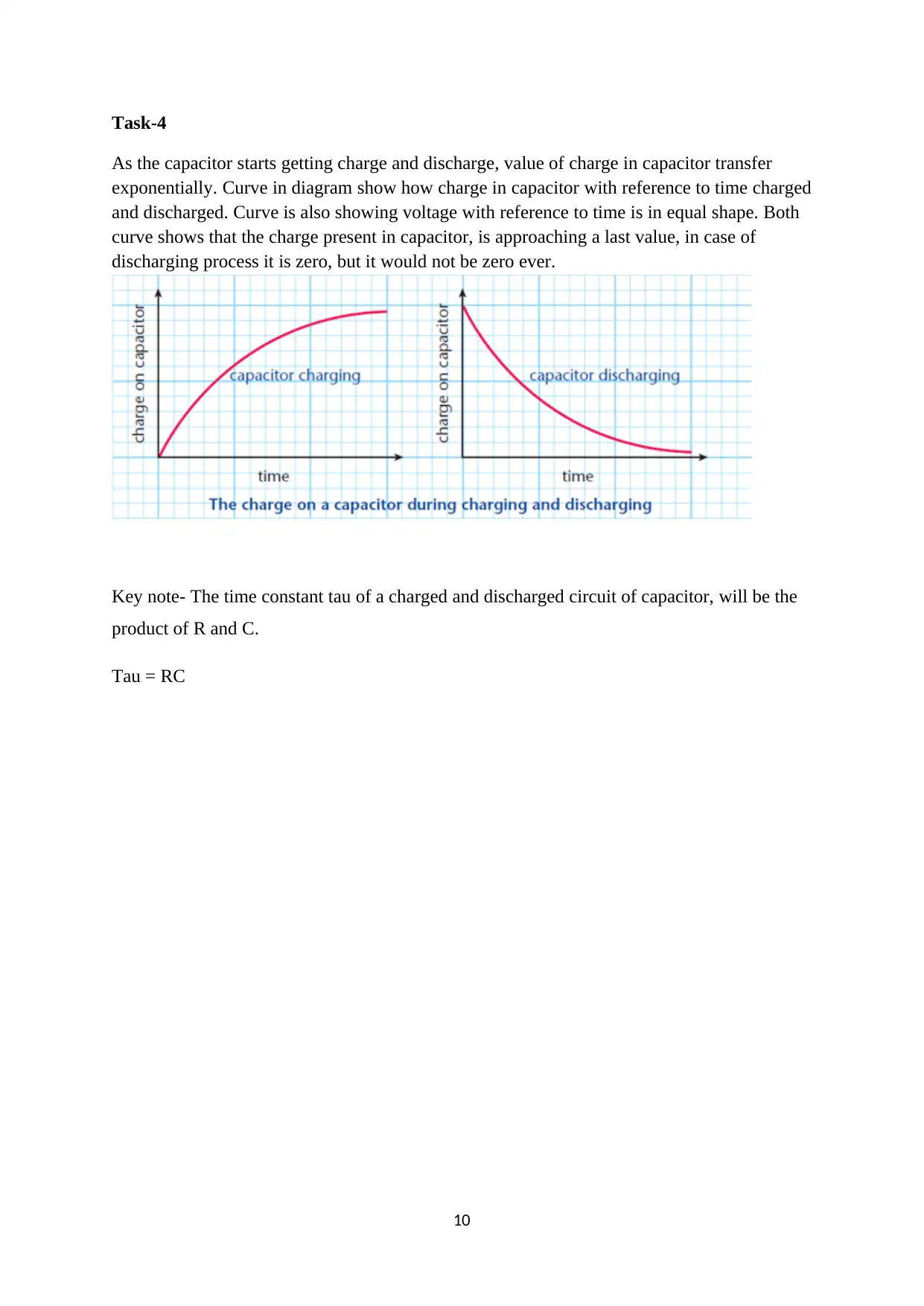
Task-4
As the capacitor starts getting charge and discharge, value of charge in capacitor transfer
exponentially. Curve in diagram show how charge in capacitor with reference to time charged
and discharged. Curve is also showing voltage with reference to time is in equal shape. Both
curve shows that the charge present in capacitor, is approaching a last value, in case of
discharging process it is zero, but it would not be zero ever.
Key note- The time constant tau of a charged and discharged circuit of capacitor, will be the
product of R and C.
Tau = RC
10
As the capacitor starts getting charge and discharge, value of charge in capacitor transfer
exponentially. Curve in diagram show how charge in capacitor with reference to time charged
and discharged. Curve is also showing voltage with reference to time is in equal shape. Both
curve shows that the charge present in capacitor, is approaching a last value, in case of
discharging process it is zero, but it would not be zero ever.
Key note- The time constant tau of a charged and discharged circuit of capacitor, will be the
product of R and C.
Tau = RC
10
Paraphrase This Document
Need a fresh take? Get an instant paraphrase of this document with our AI Paraphraser

Task-5
The charging time of capacitors normally refers to the time taken by the capacitors, when
power supplied from a source to an RC circuit, to reach full source voltage starting from zero
initial across the voltage terminals. Capacitor gets charged in a manner and discharged in also
a manner by a resistor who is exploited for various timing purposes, like introducing delay
and changing shape of waveform by putting more and less than the values of the capacitors
and resistors, for various purposes designer can design timing circuit for controlling the
speed.
In the practical arrangement of RC circuit we often use the ten time interval because it
is easy to calculate in the laboratory and give exploited result.
11
The charging time of capacitors normally refers to the time taken by the capacitors, when
power supplied from a source to an RC circuit, to reach full source voltage starting from zero
initial across the voltage terminals. Capacitor gets charged in a manner and discharged in also
a manner by a resistor who is exploited for various timing purposes, like introducing delay
and changing shape of waveform by putting more and less than the values of the capacitors
and resistors, for various purposes designer can design timing circuit for controlling the
speed.
In the practical arrangement of RC circuit we often use the ten time interval because it
is easy to calculate in the laboratory and give exploited result.
11
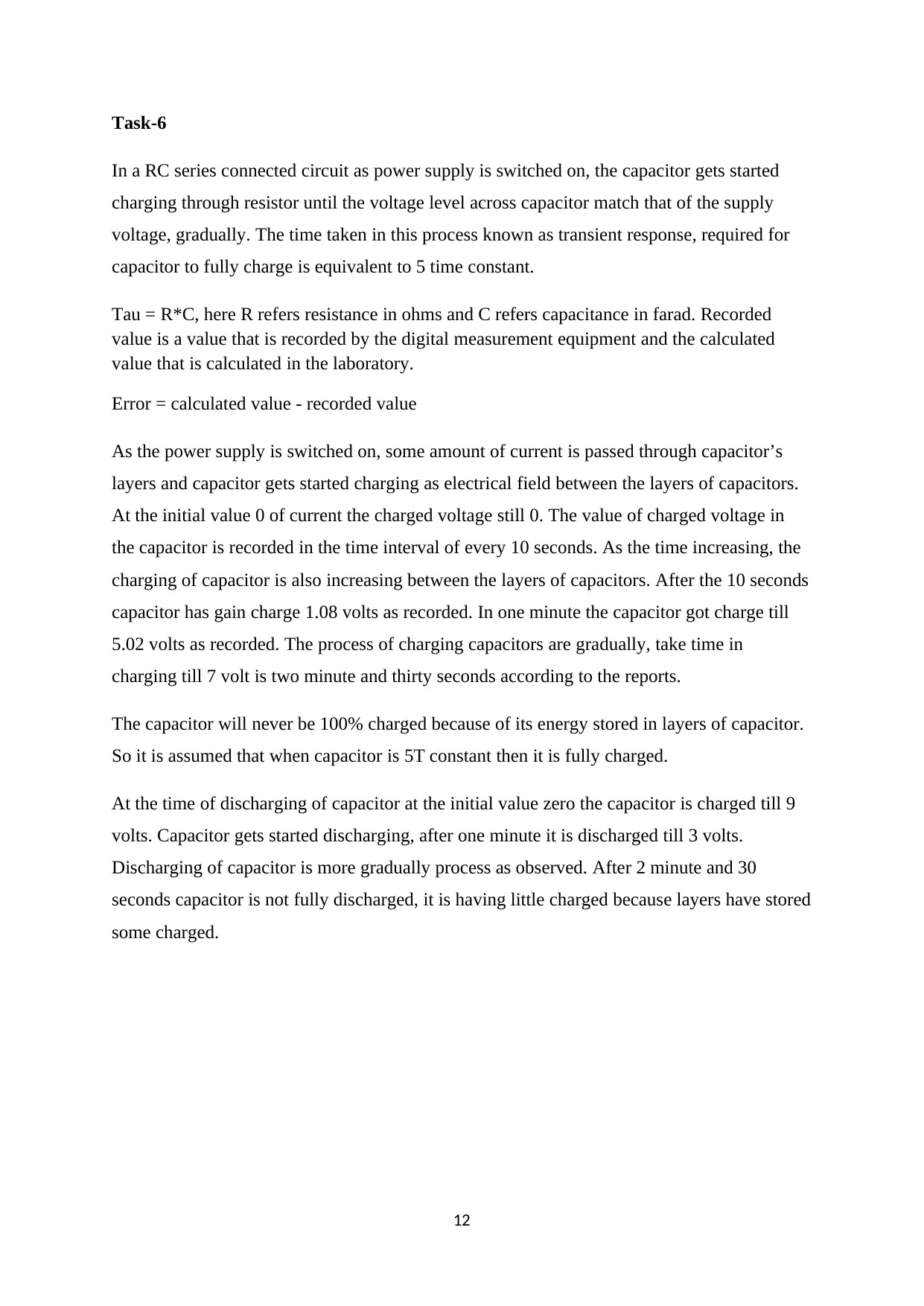
Task-6
In a RC series connected circuit as power supply is switched on, the capacitor gets started
charging through resistor until the voltage level across capacitor match that of the supply
voltage, gradually. The time taken in this process known as transient response, required for
capacitor to fully charge is equivalent to 5 time constant.
Tau = R*C, here R refers resistance in ohms and C refers capacitance in farad. Recorded
value is a value that is recorded by the digital measurement equipment and the calculated
value that is calculated in the laboratory.
Error = calculated value - recorded value
As the power supply is switched on, some amount of current is passed through capacitor’s
layers and capacitor gets started charging as electrical field between the layers of capacitors.
At the initial value 0 of current the charged voltage still 0. The value of charged voltage in
the capacitor is recorded in the time interval of every 10 seconds. As the time increasing, the
charging of capacitor is also increasing between the layers of capacitors. After the 10 seconds
capacitor has gain charge 1.08 volts as recorded. In one minute the capacitor got charge till
5.02 volts as recorded. The process of charging capacitors are gradually, take time in
charging till 7 volt is two minute and thirty seconds according to the reports.
The capacitor will never be 100% charged because of its energy stored in layers of capacitor.
So it is assumed that when capacitor is 5T constant then it is fully charged.
At the time of discharging of capacitor at the initial value zero the capacitor is charged till 9
volts. Capacitor gets started discharging, after one minute it is discharged till 3 volts.
Discharging of capacitor is more gradually process as observed. After 2 minute and 30
seconds capacitor is not fully discharged, it is having little charged because layers have stored
some charged.
12
In a RC series connected circuit as power supply is switched on, the capacitor gets started
charging through resistor until the voltage level across capacitor match that of the supply
voltage, gradually. The time taken in this process known as transient response, required for
capacitor to fully charge is equivalent to 5 time constant.
Tau = R*C, here R refers resistance in ohms and C refers capacitance in farad. Recorded
value is a value that is recorded by the digital measurement equipment and the calculated
value that is calculated in the laboratory.
Error = calculated value - recorded value
As the power supply is switched on, some amount of current is passed through capacitor’s
layers and capacitor gets started charging as electrical field between the layers of capacitors.
At the initial value 0 of current the charged voltage still 0. The value of charged voltage in
the capacitor is recorded in the time interval of every 10 seconds. As the time increasing, the
charging of capacitor is also increasing between the layers of capacitors. After the 10 seconds
capacitor has gain charge 1.08 volts as recorded. In one minute the capacitor got charge till
5.02 volts as recorded. The process of charging capacitors are gradually, take time in
charging till 7 volt is two minute and thirty seconds according to the reports.
The capacitor will never be 100% charged because of its energy stored in layers of capacitor.
So it is assumed that when capacitor is 5T constant then it is fully charged.
At the time of discharging of capacitor at the initial value zero the capacitor is charged till 9
volts. Capacitor gets started discharging, after one minute it is discharged till 3 volts.
Discharging of capacitor is more gradually process as observed. After 2 minute and 30
seconds capacitor is not fully discharged, it is having little charged because layers have stored
some charged.
12
⊘ This is a preview!⊘
Do you want full access?
Subscribe today to unlock all pages.

Trusted by 1+ million students worldwide
1 out of 14
Related Documents
Your All-in-One AI-Powered Toolkit for Academic Success.
+13062052269
info@desklib.com
Available 24*7 on WhatsApp / Email
![[object Object]](/_next/static/media/star-bottom.7253800d.svg)
Unlock your academic potential
Copyright © 2020–2025 A2Z Services. All Rights Reserved. Developed and managed by ZUCOL.



